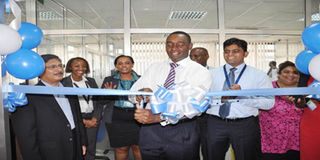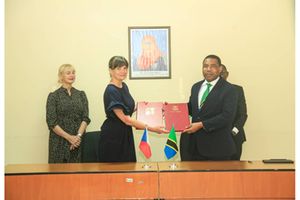Barclays Bank ‘financially stable’

Barclays Bank Tanzania managing director Kihara Maina cuts a ribbon to launch a loan collection unit in Dar es Salaam in October last year. PHOTO|FILE
What you need to know:
- It is safe from any risks that could emanate from borrowers’ failure to honour their obligations, it has explained.
Dar es Salaam. Despite having a huge burden of bad debts and doubtful loans, Barclays Bank Tanzania is financially stable, the Bank of Tanzania (BoT) says.
It is safe from any risks that could emanate from borrowers’ failure to honour their obligations, it has explained.
It maintained that the lender was operationally secure and sound financially because its non-performing loans (NPLs) had not reached alarming levels, which sector sources put at 10-15 per cent of total lending.
At the end of the third quarter, the NPL ratio in Barclays’ credit books was 7.3 per cent compared with 8.7 per cent in June and 8.8 per cent for the first three months of this year.
The head of banking supervision at the central bank, Mr Agapiti Kobello, said it was normal in lending business to have NPLs provided the doubtful loans were within acceptable levels.
According to him, the regulator has been closely watching the NPLs at Barclays and other banks and financial institutions in the country.
“BoT has required all banks with non-performing loans above five per cent to put in place strategies aimed at reducing their non-performing loans to below five per cent,” he told The Citizen on Sunday recently.
“The general level of non-performing loans in the banking sector has been gradually improving as indicated by the current industry non-performing loans ratio of 7.13 per cent as of September 30, 2013.”
BoT also said Barclays Bank’s credit deposit ratio (CDR) was still within acceptable limits; having not hit the maximum cap set on loaning, which is 80 per cent of total deposits.
However, the latest financial statements of the bank showed that the CDR, which is also called the loan deposit ratio (LDR), has reached almost 78 per cent.
That ratio calls for lending vigilance, which Barclays has been doing, and it is an alarming rise compared with the LDRs of around 73 per cent and 68 per cent in the second and first quarters of this year respectively.
At the end of the third quarter, its loans portfolio was worth nearly Sh349 billion compared with Sh360 billion at the end of June and that was against customers’ deposits of Sh446 billion and Sh436 billion for the two periods respectively.
The latest figures put total assets at Sh555.2 billion against Sh433.4 billion in 2009 and Sh579.5 billion at the end of last year.
“The Bank of Tanzania’s assessment of Barclays Bank is that it is well capitalised and making profit,” Mr Kobello noted when asked about the financial stability of the bank after it had recently stopped issuing new loans and suspended lending to new customers.
“Barclays Bank suspended lending to retail customers on all retail products to manage its internal limits and observe the regulatory limit of 80 per cent of total loans to total deposits,” he said last month.
“However, the bank has not suspended or stopped lending other types of loans. From January 2013 to September 2013, the bank’s loan portfolio grew by 14.96 per cent,” he added.
The Citizen on Sunday has learnt that the suspension of lending to retail customers was imposed on April 16 this year and re-introduced in the third quarter but to a few selected customers.
The bank’s head of marketing and communications, Ms Neema-rose Singo, said the greatest challenge for Barclays in its unsecured lending has been the high default rates on loans.
Bankers are upbeat that the default risks will be reduced following the licensing of credit reference bureaus for vetting borrowers and the introduction of national identity cards.
Mr Kobello said Tanzanians ought to develop a loan repayment culture because defaulting on credit was one of the factors that make borrowing expensive in the country.
Barclays, which is among the biggest banks in the country in terms of total assets and lending, has striven to clean up its loan book since 2009 when it had an NPL ratio of 19 per cent that rose to 24 per cent the following year.
The Tanzania Banking Survey 2013 said the bank had striven to generate meaningful returns since 2009 when it took sizeable provisions which instead resulted in losses that still haunt it today.
Measures to revitalise the lender have also included closure of 10 branches and retrenchment of 100 workers last year.
“BoT is aware that Barclays Bank Tanzania is making efforts to reduce the level of non-performing loans, and one of the efforts has been to have conservative lending to retail customers against which most non-performing loans emanated,” Mr Kobello said.
At the end of June, the loans it had advanced to customers that had not been serviced for 90 days amounted to some Sh33.3 billion.
These non-performing loans were about Sh33.6 billion at the end of the first quarter of this year but had slipped to Sh26.6 billion at the end of September.




